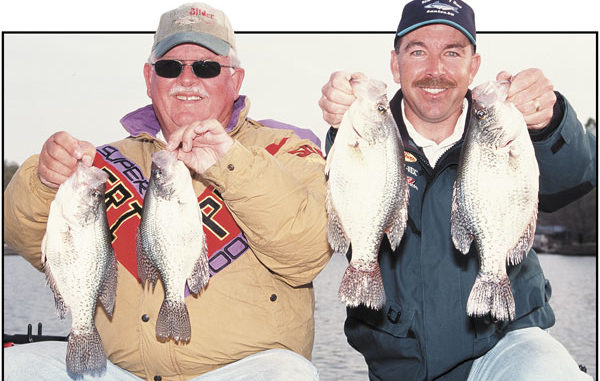
October is prime time to catch slab crappie around Lake Wylie’s boats docks.
When the leaves start to change colors, Jerry Neeley and Ed Duke start to change fishing tactics. It takes a something a good bit different to keep filling the cooler with slab crappies from Lake Wylie when summer turns to fall.
Gone are the spider rigs and trolling a dozen jigs at a time. Gone is all that open water required when your boat is crawling along at one mile per hour, covering acres and acres and acres.
What replaces them?
For Neeley, a guide from Bessemer City, and Duke, a tournament crappie fisherman from Concord, the game becomes one played with short, ultralight spinning rods, wispy monofilament that recalls silk thread and tiny jigheads dressed with the latest in crappie-catching plastic or bucktails.
“Lake Wylie is a brushpile, boat-dock fishery in the fall,” Duke said. “You can catch ’em trolling, but in the fall, that’s not nearly as productive as you can be fishing around docks and brush. You can catch 25 to 50 fish under a dock at Lake Wylie. You fish 20 docks in a day, you find two or three that are holding fish, and you load up.”
Neeley is in total agreement. One of Lake Wylie’s great, old-time crappie anglers taught Neeley (704-678-1043) how to fish tiny jigs around boat docks and brush piles in the mid-1960s, and he’s never forgotten — especially in the fall, when it becomes the premier technique.
“October is an excellent time to catch crappie; really, starting in September and going all the way through October, the fishing can be excellent,” said Neeley, who operates Carolinas Fishing Guide Service. “We tight-line jigs — fish them vertically — at piers that have brush piles near them or (laydown) trees that are in 12 to 15 feet of water.
“You can catch crappies trolling, but trolling can be tricky unless you get them pinned down. Fishing around docks, you can catch 125 to 150 a day if you really get on ’em.”
The things Duke and Neeley do to catch Lake Wylie’s fall crappie aren’t exactly the same, but their approaches are nearly identical. Each fall, crappie will hang out around boat docks that are extremely close to deep water — a channel or at the mouth of a creek. The basic technique is to drop a mini-jig down about 12 to 15 feet, wiggle it just right, and hold on tight.
Duke said at Wylie, as happens at many other reservoirs in the Southeast, crappie use creek channels as “highways” for much of their travel. Typically hanging out in big schools the majority of the year — except for the peak of the spawn — crappie move in and out of creeks and up and down the main river channel, finding places where they can move quickly into relatively shallow water and feast on baitfish that are attracted to stumps or brushpiles or other forms of cover.
They may move hundreds of yards up and down a creek every day, pulling up to feed near pier pilings or a pier that has brush piles sunk near its edges.
“It’s actually fantastic fishing, if you happen to know where any brushpiles are,” Duke said. “You can have a super good day if you know where the brushpiles are or what boat docks hold fish.
“The best docks are usually the ones close to deep water or close to points. It gives the crappie a better transition if they want to move in and out of deep water — and they’ll stay near the docks until the dead of winter.”
Duke concentrates at the lower end of the lake, from the Buster Boyd Bridge (Rt. 49) to the dam. Much of that area of the lake is in South Carolina. North Carolina and South Carolina don’t have a cooperative licensing agreement, so anglers must have licenses from both states and must abide by South Carolina’s creel limit of 30 fish per person per day any time they’re in Palmetto State waters.
“All the water below the bridge is deeper water, and I like to fish near the mouths of major creeks and in pockets and coves where you can find deep water,” Duke said. “If you find docks that are in 15 to 20 feet of water, the crappie will be on ’em — that’s just typical Lake Wylie fishing.
“I have never caught crappie all the way back in the backs of creeks in the fall. I don’t think the bait ever goes all the way back; I think they hang around the creek mouths.”
Duke’s favorite way to catch crappie at docks in the fall is to “shoot” mini-jigs underneath the docks and let them sink to the bottom, watching carefully to detect any change in the way the jig falls that might indicate a nibbling crappie.
“I like to ‘shoot’ docks, getting a jig as far back under ’em as you can and letting it fall,” said Duke, who will more often than not try to skip the jig back under the dock with a sharp, underhand cast. “I use a homemade 4-foot spinning rod and an open-face (spinning) reel. You skip it up under there and let it fall all the way to the bottom. The other way to do it is to use a 12-foot jigging pole and just stick the whole pole under the dock and drop the jig down there.”
Duke doesn’t believe it’s necessary to give a jig a lot of built-in action. He likes to fish a Bass Assassin jig, which has a pointed tail, a Charlie Brewer “Slider” jig or a hair jig such as a “Hal Fly.” Usually, having a bait fall down in front of his nose is enough to draw a strike from a crappie that’s using a boat dock or brush pile as an ambush point.
“You just get your jig back under there and let it fall to the depth you want it to — I count mine down (a foot per second), and I’ll experiment until I find the desired depth,” Duke said. “You may catch them shallower in the morning, then they go deeper as the day goes along. We’ve caught ’em as deep as 20 feet. Some of the docks are in 30 feet of water, and the top of the brush comes up to 20 feet and the crappie hold at 20 feet.”
Neeley follows a lot of Duke’s advice, if not the blueprint. He uses light spinning tackle to drop tiny jigs at docks, brush and laydown trees, but he doesn’t fish the mouths of creeks; he fishes the back halves. His favorites are Mill Creek, Beaver Dam Creek, Catawba Creek, Crowder’s Creek and Brown Creek.
What do they have in common? Well-defined creek channels that carry their depth well back into the back halves of creeks. To them, that means an angler is just as likely to find a creek close to deep water back there as one near the main lake.
“(Crappies) will get all the way back in the creeks in October — almost to the same places where you catch ’em in the spring,” Neeley said. “Any place you catch ’em in the early spring where you’ve got brush and a reasonable amount of water, say, 10 feet, they’ll be there in the fall. The shad will start back, and the crappie will be on ’em.
“We also target certain piers in the fall that hold a lot of fish. You may pull up to one and catch 30 or 40. And there are a lot of good blowdowns on the right side of the lake as you go up the (river). They’ve fallen all the way off the bank, and people don’t really target them because they don’t see ’em. But crappie will get out 12 to 16 feet deep on those trees, and you can work on ’em. And all you may see is one limb about the size of your arm sticking up.”
Neeley’s main October strategy is to find the edges of creek channels and follow them back into creeks, then fish the docks that are closest to them — searching especially for those docks that have brushpiles sunk near them. Or if he can find any sharp bends in a creek channel, he’ll do a lot of work with his depth-finder looking for brush that might have piled up at the outside edge of the channel or that’s been put there by another angler.
He looks for laydowns in the same places.
“In the fall, you’ll catch a lot of fish in the trees if you don’t run up in there with your big motor or your trolling motor,” he said. “I turn my motor off a few yards off the tree and estimate how I’m going to drift in; you don’t want to hit up against the tree real hard or the crappie will spook and move out. I ease in there, and if there’s a limb sticking out, I’ll get up against it and tie up to it.
“You won’t catch nearly as many fish if you bang up against the tree. Then you just jig all around the tree until you learn where all the limbs are and start to catch fish. After you’ve caught fish off the same tree 10 times, you know where to start on it.”
Neeley said he’s been fishing long enough to realize that more than half of his success crappie fishing is a matter of figuring out what kind of pattern the fish are using during any particular day and running that pattern — just like a bass fisherman does.
“What I do when I’m fishing docks with brush is run and gun,” he said. “I’ll pull up to a pier in 15 feet of water, jig along both sides and jig the front and back. If I don’t catch one, I’ll go to the next one and the next one until I hit ’em.
“Then, I’ll look and see where the fish are — are they on the shady side of the dock, or are they in the brush on the front? Is it an older dock?
“What you’re doing is trying to eliminate places you haven’t found them, then just go to all the docks that are just like the one (where) you’ve caught ’em. You might be able to think of a dozen docks where there’s brush on the shady side, and you run to them. That’s how you really catch a lot of crappie.”
When an angler finds crappies in good numbers and catch a lot of ’em, the chances of bringing home some big slabs are good, Duke said.
“You’re going to average almost a pound (per fish) in the fall, and you’ll catch some hogs, some big hammers up to a pound-and-a-half — mostly black crappie,” he said.

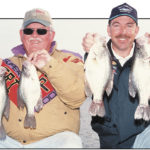
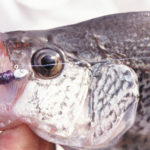
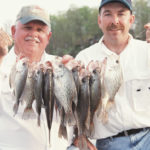
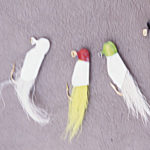
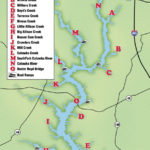



Be the first to comment